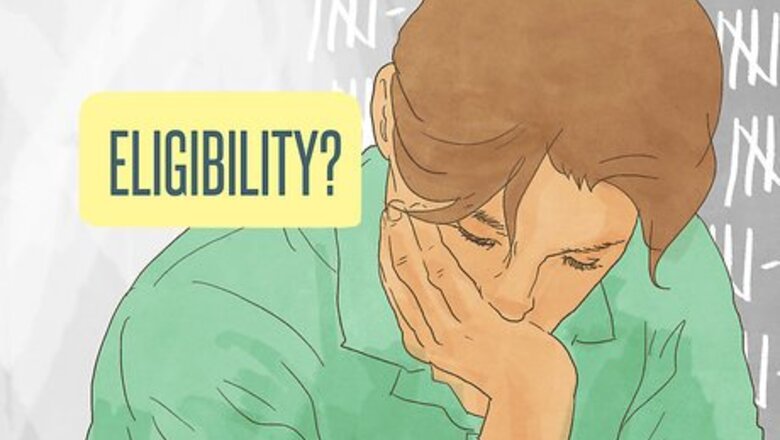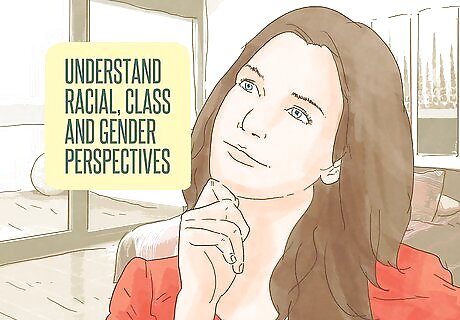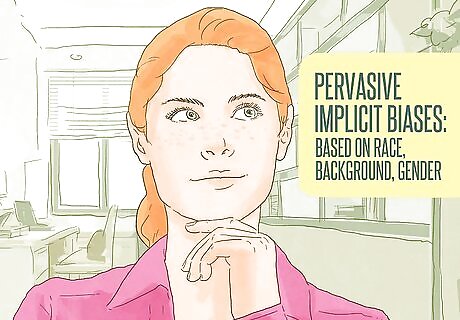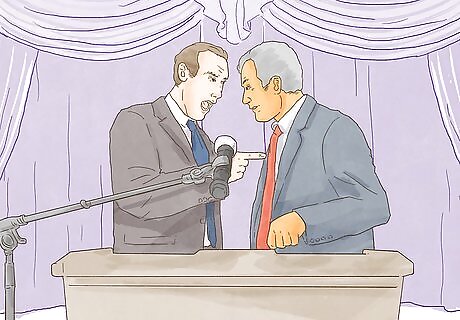
views
Placing Yourself on the Political Spectrum

Consider the policies most important to you. When you think about politics, what issues do you think about? What stances do you normally sympathize with, and which ones could you care less about. Before trying to place yourself on the left or right-wing, remember to think about your own political spectrum without thinking about "sides." Ask yourself the following questions, knowing that there is no correct answer: Do you think the government should try to make life better, or should stay out of the way for other people to make life better? Do you think your country should assist other countries in wars or global issues, or should it only respond when it is directly attacked? Do you think the government should help make the economy more fair, or does regulation stifle businesses and entrepreneurs?

Determine your general political position with an online political survey. Sites like the political compass can be a good way to get your political baseline. These sites test out your political position on a variety of issues, usually asking you to rank how important the idea is or how much you agree. When done, you can use these answers to help you dive into some of the suggested pages, ideas, and parties. Take more than one quiz to avoid biases and mistakes found in one alone. Don't take these quizzes without a grain of salt. Instead, check out the political parties and sites they suggest. Do these sites also match up with your general viewpoints?

Read over the basic positions of both sides. Again, you don't have to agree with all of one side, and you generally shouldn't. This is why thinking of your own beliefs first is important -- it lets you sort out what is important to you instead of letting you feel dragged to one side or the other: Those on the left-wing may support: Social welfare programs (food stamps, homeless shelters, unemployment benefits). Separation of church and state. Higher taxes on the wealthiest members of society to fund social programs. Environmentalism and green initiatives. Strong trade unions and industry regulations. Social change or social justice to create equality. Stronger federal (national) government, as opposed to stronger state governments Those on the right-wing may support: Strong moral and religious values. Belief that charities, churches, and communities should provide social welfare, not the government. Lower or flatter taxation to cut government programs. Limiting the scope of government, with emphasis on freedom of the individual. The strength of free-market capitalism, both at home and abroad. Reducing regulations on industry and business. Stronger powers to state and local governments, with a weaker federal government.

Be aware of political bias. Again, this is why it is important to make your own mind up before diving into other people's interpretations. If you decide you're "right-wing," ask yourself how often you let yourself see "left-wing" news. Often the reason you choose one side is because you haven't been exposed to the other. This is often known as the political "echo-chamber," where you only hear the same views over and over. While these change frequently, test out some of the sites "across the aisle" from you to get better news: Conservative Leaning News: Fox News, The National Review Liberal Leaning News: The Washington Post, New York Times, MSNBC, Buzzfeed, CNN, The Huffington Post.

Remember that political views are a spectrum. You can place yourself anywhere between left and right based on your unique views. One of the biggest tragedies in American politics is the insistence that you must be either "left" or "right," and you can't disagree with your own side. Real humans, however, are not so perfectly ordered. We agree with some policies and disagree with others regardless of what side they fall on. Remember to stay true to yourself, not the prescribed beliefs of each side, to truly understand your political leanings.
Understanding Your Right-Wing Views

Consider right-wing policies as a generally "conservative" political view. Conservatism is currently the most right-wing branch of political thought in the United States, though what conservatism actually is only become harder to define. Currently, conservationism and right-wing ideologies are generally used interchangeably in conversation, and you can usually assume conservatives will consider themselves as "right-wing" and vice versa. Both believe: A smaller government is a stronger government. Free, unregulated markets create the most wealth. Strong moral, traditional, and religious values are key to a strong nation.

Think about social issues separately from economic or political issues. One of the biggest differences among right-wingers comes on social policy. Specifically, the difficult line between "limited government" and "strong social values." At what point, to you, is the government getting too involved in social life, and when is appropriate for the government to get involved at all? Take an issue like same-sex marriage, for example. Two right-wingers might come to surprisingly different interpretations based on the same tenets: More socially conservative: The institution of marriage is thousands of years old, and has always been "one man, one woman." This should not change now when it has worked well before. More economically conservative: The government has no right to get involved in something as personal as marriage, and people should do (or marry) whoever they want. This is not something worth spending tax dollars on.

Acknowledge the positions of "far-right" candidates and ideas. There are many degrees of right-wing thought, from the surprisingly moderate ideas of Richard Nixon to the intensely conservative ideology of Ted Cruz. While the Republican Party is generally considered the party of the right-wing, the 2016 primary shows just how big that conservative tent is. Far-right candidates, in general, believe: The government must be significantly and immediately slashed down, getting out of healthcare, taxation, regulation, and social programs like Social Security and welfare. The government has an obligation to uphold strong Christian values across the nation. The Constitution is infallible and should be the first source of information on legal disputes. The free market, when businesses and consumers do what they want without intervention, will solve most, if not all, problems over time.

Follow parties and candidates sympathetic to right-wing causes. In general, the Republican Party is considered America's "right-wing" party. This makes it the frequent "landing zone" for new conservatives, but it is hardly your only option. Republicans generally believe in lower taxes, regulation, and immigration, but stronger promotion (with laws) of stronger social and moral values. As the 2016 U.S. presidential election has shown, there are a lot of different views, candidates, and ideas about what it means to be right-wing: The Libertarian Party: Libertarians emphasize individual rights and freedom over group rights. In the economic sphere, with some exceptions, they are close to traditional conservatism. They favor free markets and want as little government as possible and scaling back economic regulations heavily, but favor the decriminalization of drugs. In the social sphere, they are somewhat liberal. They oppose government discrimination for or against any group, but oppose government influence over social/religious life, and advocate for the right of an individual to choose with whom they associate or do business with. The Constitution Party: A socially conservative wing that promotes traditional and religious social order through strong government presence. The American Party: Socially and economically conservative, the American Party specifically hopes to remove the US from world politics, including slashing our foreign aid, position in the UN, NATO, and other world organizations, and stronger civilian oversight on foreign policy.
Understanding Your Left-Wing Views

Consider left-wing policies as a generally "liberal" view. Liberalism has been redefined many times over the years, but most people today use it almost synonymously with left-wing ideology. As such, most people will consider themselves both left-wing and liberal at the same time. Both believe that: A large, central government is essential to run the country smoothly. The free market gives too much power to businesses, and must be regulated to ensure consumers are treated fairly. The government must actively protect the rights of ethnic minorities and at-risk populations.

Distinguish between social policy and economic policies. The left-wing is not a precise set of ideals that everyone agrees with. Just like right-wing ideology, the most common split is over social and economic policy, with equally left-wing groups capable of taking different "liberal" stances. For example, think about how two different left-wingers might approach affirmative action, which is a policy aimed at reducing social inequality amongst people from ethnic minority backgrounds. In which, a company is legally required to hire people from ethnic minority backgrounds, as they are statistically more likely to be unemployed than White people are. Critics claim the policy is racist against the White majority of the population, as they are deliberately given a disadvantage in the recruitment process.: More socially liberal: Minorities face untold, and unseen, discrimination at all levels of hiring. A small boost will help even this playing field after decades of hateful laws, policies, and attitudes, even if it means some people will be left behind. More economically liberal: Acting like some groups are "worse" and need a boost drives down long-term growth, and lack of education and resources is a more important issue. The real issue is in wealth distribution, not hiring policy, even though this doesn't help the current generation.

Know where the "far-left" stands. Extreme liberals, often known as those "on the far-left," generally believe that the government has an obligation to fix a variety of wrongs, and that the government is better suited to handle problems and spend money than individuals. As such, the far-left generally believes: Capitalism, particularly free-market capitalism, only concentrates power in the hands of a wealthy few, destroying the working-class. Companies and individuals will not treat ethnic minorities or disenfranchised groups with respect unless compelled (by regulation or incentive) to do so. There are some things (like the environment) too important to trust people with doing, and thus the government must control group efforts to tackle these issues.

Follow parties and candidates sympathetic to left-wing causes. In general, the Democratic Party is considered America's left-wing party; even though it would be classed as "centrist" by European standards, compared to a left-wing party in Europe. This makes it a good first place to go for burgeoning liberals, as the Democrats generally believe in government-enforced social equality for all people, higher taxes on higher earners, and moderate environmental and economic regulation. However, this is not the only option for impressionable left-wingers: The Green Party: One of America's biggest third parties, they focus on economic equality, a strong commitment against global warming and pollution, and expanded social rights for all. The Justice Party: A relatively new party, the Justice Party's primary goal is to challenge the influence and big businesses on politics. They argue this can only occur through stronger regulation. The Working Families Party: Supports Democrats and Republicans, though sticks to a center-left policy of stronger labor unions and worker support, higher minimum wage, and other middle-class protections against strong business interests.



















Comments
0 comment